Japanese architecture and its architects are world-renowned. The style tends to be a beautiful mix of Japanese traditional and contemporary architecture. Many people travel to see such works. This article features famous architects, firms, requirements as well as recommended schools to become an architect in Japan.
First Published: 2021/10/13
Updated: 2024/04/18
Table of Contents
- Brief Intro to Japanese Architecture
- Famous Japanese Architects
- Must-know Architecture Firms in Japan
- Studying Architecture in Japan
- Architect Jobs in Japan
- Find an Architect Job in Japan with WeXpats
 Are you having any issues with job-hunting in Japan?
Are you having any issues with job-hunting in Japan?
Brief Intro to Japanese Architecture

If you’re unfamiliar with Japanese architectural styles, taking a look at the various types of historic architecture around the country is the easiest way to see the traditional aspects still preserved in many designs today. The most obvious places to look are Japanese shrines, temples and castles. While influences have carried over from other Asian countries, Japanese architecture evolved into something unique on its own.
Here are some articles about architecture and design to get you started:
Writer's Pick
Famous Japanese Architects
Many modern architects incorporate aspects and ideology of Japanese traditional architecture - whether it be the materials, symbolic meaning, use of space, etc. - in their present-day designs. They also incorporate innovative technology to reflect the advancements in Japan in the modern world.
First, we’ll introduce just some of the famous architects of Japan who have contributed to the development of Japanese architecture and have won the prestigious Pritzker Architecture Prize. A brief introduction to their individual styles is followed by a list of notable projects.
Kenzo Tange
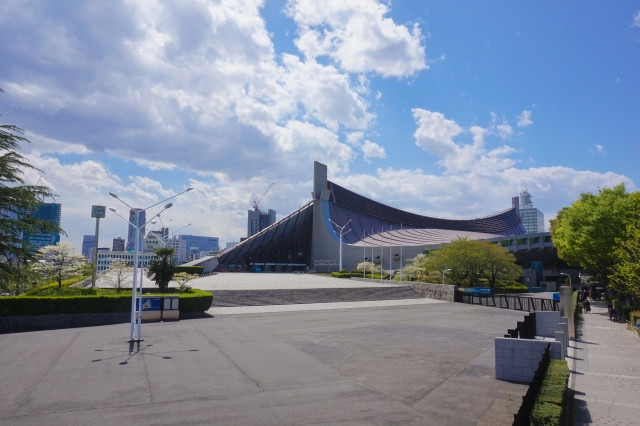
Tange is considered a Japanese legend in the architecture world who won the 1987 Pritzker Prize. His style of work was a combination of traditional Japanese styles with modern architecture. He has designed major distinctive buildings in Tokyo and in cities around the world. Tange’s most famous design is the Hiroshima Peace Memorial Park in Hiroshima, Japan. His other major projects include the Yoyogi National Gymnasium for the 1964 Summer Olympics in Tokyo (pictured above), and the Tokyo Metropolitan Government Building.
Kazuyo Sejima and Ryue Nishizawa
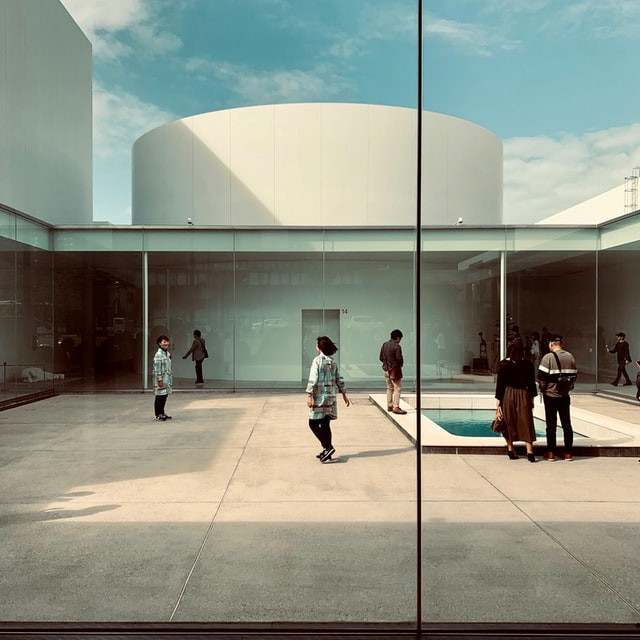
Kazuyo Sejima and Ryue Nishizawa are the founding partners of the architecture firm Sejima and Nishizawa and Associates known as SANAA. They are also the Pritzker Prize holders in 2010. Nishizawa became the youngest recipient of this prestigious award at the time. A few of their famous projects are The 21st Century Museum of Contemporary Art in Kanazawa, Japan (pictured above), Zollverein School of Management and Design in Germany, The New Museum of Contemporary Art in New York and The Sumida Hokusai Museum in Tokyo, Japan.
Toyo Ito
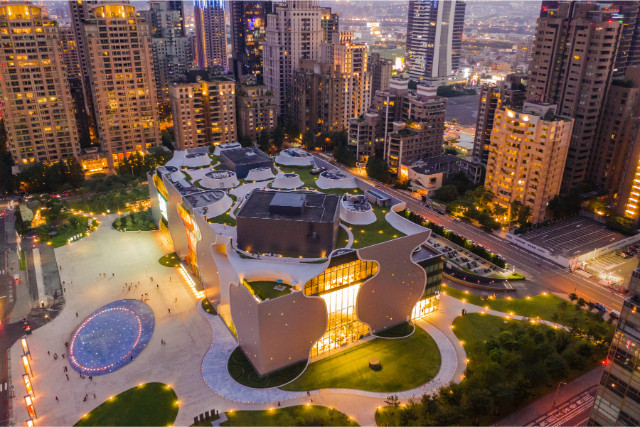
Ito is a Japanese architect who won the Pritzker Prize for Architecture in 2013 for his achievements and works in conceptual architecture. He is the founder of the firm Toyo Ito & Associates, Architects. Some of his famous projects are: Toyo Ito Museum of Architecture in Imabari, Japan, Library of Tama Art University in Tokyo, Za-Koenji Public Theater in Tokyo and National Taichung Theater in Taiwan (pictured above).
Arata Isozaki
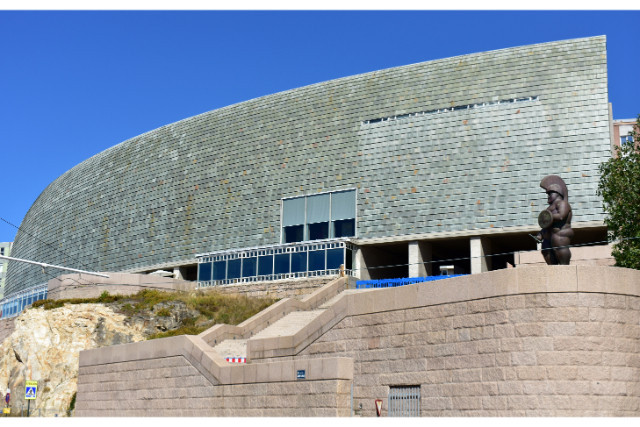
Isozaki was the eighth Japanese awardee of the Pritzker Architecture Prize in 2019. Isozaki worked under Kenzo Tange after graduating from university. Isozaki's work progressed from somewhat European to modern designs. His well-known projects are Fujimi Country Club and Kitakyushu Central Library in Japan, Art Tower of Mito in Japan and Domus-Casa del Hombre in Galicia, Spain (pictured above), and The Museum of Contemporary Art (MOCA) in Los Angeles.
Must-Know Architecture Firms in Japan
For aspiring architects, it’s important to not only know famous architects but also firms in the industry that can provide the best experience to an architect. We have listed 5 such firms that cover a range of architectural subjects and projects, from residences to public spaces. Perhaps some readers will aim to work with them in the future as these firms also hire foreign employees.
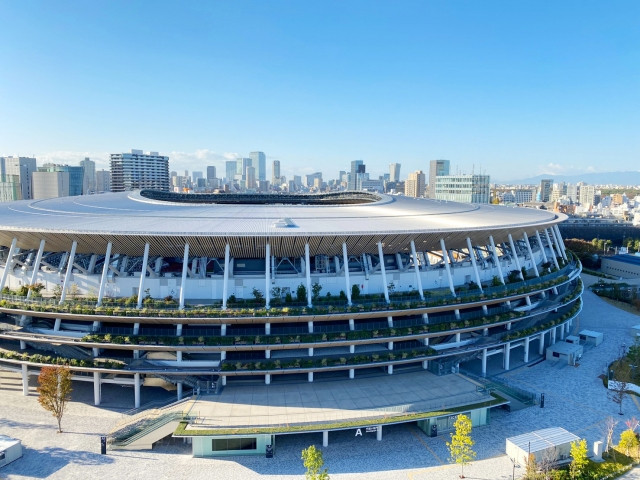
Kengo Kuma & Associates (based in Tokyo)
Famous projects: Akagi Shrine (Kagurazaka), Kadokawa Cultural Museum, Meiji Jingu Museum, National Stadium (pictured above)
Website: kkaa.co.jp
Arbol (based in Osaka)
Projects: mainly residences, Hanare (Guest House), Public Facility Open Renovation KIITO, Miyoshi Bakery
Website: arbol-design.com
Hata Tomohiro Architect & Associates (based in Kobe)
Projects: mainly private residences (eg. Earth House), Okura Coast Park Facility, Sannomiya Platz,
Website: hata-archi.com
Akihiro Kondo Architecture (based in Osaka)
Projects: mainly private residences with special requests, such as a pool house, luxury garage, etc.
Website: ak-archi.com
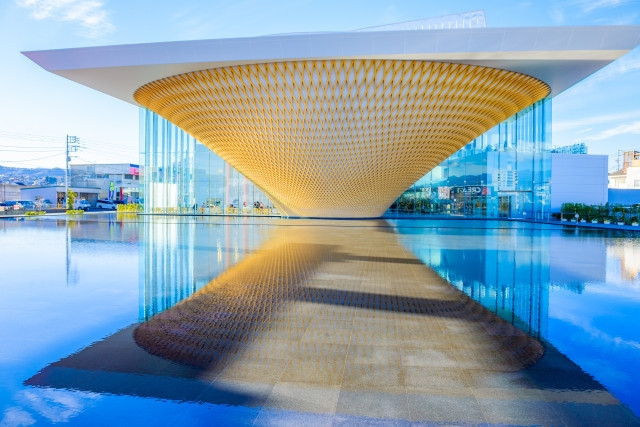
Mount Fuji Architects Studio (based in Tokyo)
Projects: Mount Fuji World Heritage Center (pictured above), Rooflag
Website: http://fuji-studio.jp
Studying Architecture in Japan
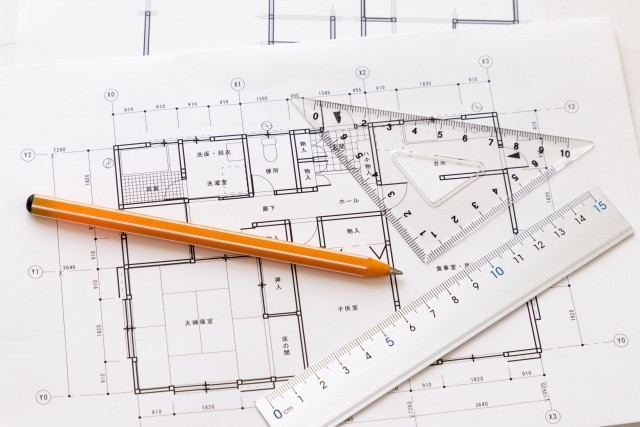
To be an architect in Japan, of course, you need the education and the language skills for it. Going to school in Japan would be the most common way most architects in Japan get their education and license. Many international students go the graduate school route.
Most schools don’t offer a program in just English so your Japanese language skills will more than likely have to be quite high. (And, it’s important to know Japanese anyway to communicate with future clients). In order to get admission to an architecture university, you may need to pass entrance examinations held by specific universities. We will list some of the universities you can look into below.
-
University of Tokyo - masters program in mostly Japanese or the Architecture and Urban Design Course master’s program in English
-
Meiji University - International Program in Architecture and Urban Design masters program in English
-
Keio University - Graduate School of Science and Technology while enrolled in a lab at Keio Architecture (Japanese program with some English classes)
-
Kyoto University - Architecture and Architectural Engineering taught in English
-
Tohoku University - Department of Architecture and Building Science graduate courses mostly taught in Japanese.
-
Tsukuba University - Architectural Design undergraduate program in Japanese
There are many schools out there to look at with a mix of programs in English and Japanese. But again, learning Japanese is highly recommended especially if you intend to stay and work in Japan.
Architect Jobs in Japan
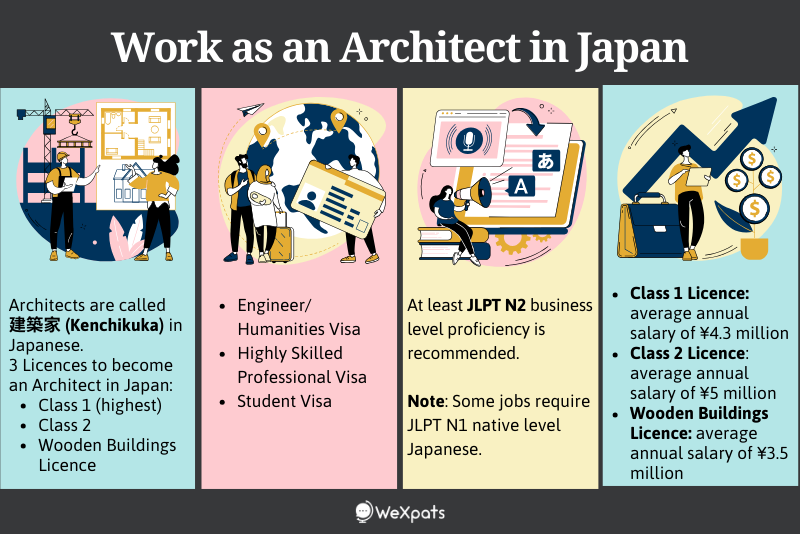
Skill Requirements to be an Architect in Japan
In Japan, architects are called 建築家 (Kenchikuka), or 建築士 (Kenchikushi) - which both architects and building engineers. Thus it’s often not just about design but actually learning the engineering side as well.
There are 3 main licenses you can get as Kenchikuka.
- Class 1 License (highest)
- Class 2 License
- Mokuzo (wooden buildings) License
Class 1 is the highest level and you would have to pass a national exam to get the license. Class 2 and Mokuzo are given at a prefectural level.
The different licenses allow architects and building engineers to work with certain types of buildings and structures related to scale, size (number of floors, etc.), material and so on.
You qualify to take the exam if you have met the requirements for education and practical experience. Each license requires a different amount. For example, if you went to a 4 year university and majored in architecture, then you can immediately take the Class 2 License and then you will need 2 years of practical experience before you can take the Class 1 license. Thus the type of education you get is important.
※The Japan Architectural Education and Information Center ※e-gov, “建築士法”
You'd also need a certain level of Japanese language ability. While there may be some architect firms that deal mainly with foreign clients, or will hire you to be a person in charge of non-Japanese clients, most architecture firms will require Japanese. The requirement will most likely be N2 level (to study architecture in Japan in a non-Japanese program, N2 minimum is often required) while some firms may even ask for N1.
Depending on the firm, they may ask for other requirements such as experience and/or a portfolio of past work/projects/designs.
One way to get experience (especially while a student) is to do an architecture internship in Japan.
Visa Requirements to be an Architect in Japan
To work as an architect in Japan, you need to obtain a working visa. The firm you are joining should be able to sponsor you and provide the paperwork for your visa, so make sure when you are in the process of being hired.
If you are just starting out, and want to take up architecture studies in Japan, you will fall under the Student Visa. But if you were already an architect abroad and you wish to continue to be one in Japan, a Highly Skilled Professional Visa is probably what you are looking for. For this visa, you need at least 10 years of experience in architecture.
※ Ministry of Foreign Affairs, "Work or Long-term stay”
Architect Salary in Japan
With a Class 1 License, the average salary is roughly 6.5 million yen, while with a Class 2 license, it’s about 5 million yen. The average salary for people with a Mokuzo (wooden buildings) License is around 3.5 million yen.
Of course the actual salary depends on experience, age, size of company, etc.
※CIC, “How much is the annual salary of an architect?”
Find an Architect Job in Japan with WeXpats

WeXpats operates a service for foreign nationals who want to work in Japan. There are jobs in a variety of industries including construction jobs like architecture and civil engineering. There are 2 services available on WeXpats - WeXpats Agent for full time jobs and WeXpats Jobs for part time jobs.
Looking for a Full Time Position? Leave it to WeXpats Agent!
WeXpats Agent is a career support service that specialises in employment for foreign nationals living in Japan.
Recruitment agencies in Japan are a service where dedicated career advisors will assist you with your job hunt for free. In addition to introducing open positions, we also provide support to help you create your Japanese resume and practice for interviews. Worried about job hunting in Japanese? We are here for you.
Features of WeXpats Agent
-
We have many job openings that are a good fit for foreign nationals to work in, such as translation, interpretation, inbound, etc. jobs that make use of your language skills, as well as engineering etc. jobs that do not require Japanese skills.
-
Our career advisors support and help you prepare your resume and practice job interviews with you. Clearly communicate your strengths to the hiring company.
-
We will handle communication with companies on your behalf, such as arranging interview dates and negotiating conditions. And thereby reducing your stress and time spent.
Finding a Part Time Job? Browse on WeXpats Jobs!

WeXpats Jobs is a part time job site for foreign nationals living in Japan. You can search for jobs in 11 languages (English, Vietnamese, Korean, Indonesian, Traditional Chinese, Simplified Chinese, Burmese, Thai, Spanish, Portuguese), including Japanese. Find jobs that suit you by specifying your Japanese language level, occupation, location, and etc.
※ You can register from outside Japan, but only those living in Japan can apply for jobs.

































